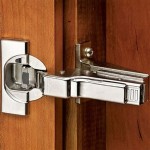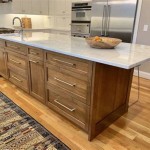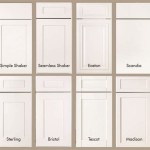Standard Width of Kitchen Drawers: A Comprehensive Guide
Kitchen design involves careful consideration of numerous elements to achieve functionality, aesthetics, and optimal space utilization. Among these elements, drawer dimensions, particularly width, play a crucial role in determining storage capacity, accessibility, and overall kitchen workflow. Understanding the standard widths available for kitchen drawers allows homeowners, designers, and contractors to make informed decisions that cater to specific storage needs and spatial constraints.
While "standard" implies a fixed dimension, the reality is that kitchen drawer widths exist within a range. These common ranges are influenced by cabinet construction practices, the availability of drawer hardware, and the ergonomic considerations related to reaching and accessing stored items. Deviation from these ranges necessitates custom cabinet work, potentially increasing project costs and lead times.
This article provides a comprehensive overview of standard kitchen drawer widths, exploring the common dimensions, factors influencing width selection, and the implications for kitchen design and organization. Understanding these nuances is essential for creating a kitchen that is both visually appealing and highly functional.
Common Kitchen Drawer Width Ranges
The most prevalent range for kitchen drawer widths typically falls between 12 inches and 36 inches. This range accommodates a variety of storage needs, from small drawers for utensils to wider drawers designed for pots, pans, and other bulky items. Within this broader spectrum, specific increments are more frequently encountered due to standard cabinet construction practices.
Drawers measuring 12 inches to 18 inches wide are often used for utensils, cutlery, spices, and smaller kitchen tools. These narrower drawers are suitable for placement beside ranges or dishwashers, where space may be limited. Their smaller size prevents items from becoming disorganized and difficult to locate.
Drawers ranging from 24 inches to 30 inches in width are commonly found under countertops and are utilized for storing mixing bowls, plates, and other commonly used kitchen items. These mid-sized drawers strike a balance between storage capacity and ease of access. They are often configured as stacked drawers, with one or two shallower drawers above a deeper drawer.
Drawers measuring 36 inches wide represent the upper end of the standard range. These wide drawers are ideal for storing large pots, pans, baking sheets, and other bulky items. They require robust drawer slides to support the increased weight and are typically positioned in base cabinets specifically designated for heavy-duty storage. Careful consideration should be given to the arrangement of items within these wide drawers to prevent clutter and ensure easy retrieval.
It is important to note that these are general guidelines, and variations may exist depending on the cabinet manufacturer, the style of cabinetry (e.g., framed vs. frameless), and regional preferences. Consulting with a cabinetmaker or kitchen designer is recommended to confirm the availability of specific drawer widths and to assess their suitability for the intended application.
Factors Influencing Kitchen Drawer Width Selection
Selecting the appropriate width for kitchen drawers involves considering several interconnected factors, including storage needs, kitchen layout, cabinet style, hardware availability, and ergonomic considerations. Neglecting any of these aspects can lead to a kitchen that is either inefficient or aesthetically unappealing.
The primary determinant of drawer width is the type and quantity of items to be stored. A thorough inventory of existing kitchenware and supplies is crucial for determining the necessary drawer space. Items should be categorized based on size and frequency of use to allocate appropriate drawer dimensions. For instance, frequently used utensils should be stored in readily accessible, narrower drawers near the cooking area, while infrequently used baking dishes can be stored in wider drawers further away.
The overall layout of the kitchen also significantly influences drawer width selection. Kitchens with limited space may necessitate narrower drawers to maximize storage capacity without compromising circulation and work zones. Conversely, larger kitchens may accommodate wider drawers, providing ample storage and improved organization. The placement of appliances, such as dishwashers and ranges, can also dictate the available space for drawers.
The style of cabinetry, whether framed or frameless, affects the usable interior width of drawers. Framed cabinets, which feature a face frame surrounding the cabinet opening, typically reduce the available drawer width by a small amount (usually 1 to 1.5 inches) compared to frameless cabinets. This difference can be significant, especially when optimizing storage in smaller kitchens.
The availability of drawer slides and other hardware components is another important consideration. Drawer slides are responsible for supporting the weight of the drawer and ensuring smooth operation. The weight capacity and adjustability of the slides should be compatible with the intended contents of the drawer and the overall drawer width. Wider drawers inherently require stronger slides to prevent sagging and ensure longevity.
Ergonomic considerations also play a role in drawer width selection. Wider drawers, while providing ample storage, can become unwieldy if they are too deep or difficult to reach into. Careful consideration should be given to the depth of the drawer and the height of the user to ensure comfortable access to stored items. Pull-out shelves or tiered inserts can improve accessibility in deeper drawers.
Implications for Kitchen Design and Organization
The selected drawer widths directly impact the overall design and organization of the kitchen. Strategic placement of drawers with appropriate dimensions contributes to a functional and efficient workspace. Conversely, poorly planned drawer layouts can lead to clutter, wasted space, and difficulty in accessing stored items.
By incorporating a variety of drawer widths, a kitchen can be tailored to accommodate specific storage needs. Narrower drawers can be used to organize cutlery, utensils, and spices, preventing them from becoming jumbled together. Mid-sized drawers are suitable for storing plates, bowls, and frequently used cooking tools. Wider drawers can be used for pots, pans, and baking sheets, keeping them readily accessible. Utilizing dividers and inserts can further enhance the organization within each drawer.
Drawer placement should also be carefully considered relative to work zones. Drawers containing utensils and cooking tools should be located near the range, while drawers containing dishes and silverware should be located near the dishwasher and dining area. This strategic placement minimizes movement and improves workflow during meal preparation and cleanup.
The aesthetic impact of drawer widths should not be overlooked. Uniform drawer fronts can create a clean and contemporary look, while varying drawer heights and widths can add visual interest and break up the monotony of a long cabinet run. The choice of drawer pulls and knobs also contributes to the overall aesthetic and should complement the chosen cabinet style.
Furthermore, the interior organization of drawers can maximize storage space and improve functionality. Drawer dividers can separate different types of utensils or spices, preventing them from mixing together. Knife blocks or inserts can safely store knives, protecting both the user and the knives themselves. Pull-out shelves or tiered inserts can improve accessibility in deeper drawers, making it easier to reach items at the back. Proper organization not only improves efficiency but also prevents damage to stored items.
In conclusion, understanding standard kitchen drawer widths and the factors influencing their selection is vital for creating a functional, aesthetically pleasing, and efficient kitchen. By carefully considering storage needs, kitchen layout, cabinet style, hardware availability, and ergonomic considerations, homeowners and designers can make informed decisions that optimize storage capacity, improve workflow, and enhance the overall kitchen experience.

Cabinet Sizes Blok Designs Ltd

Kitchen Cabinet Drawer Dimensions Standard Inspiration Ideas 3 Decorating Cabinets Height Measurements

Cabinet Sizes Blok Designs Ltd

Cabinet Face Dimensions

When Is A Drawer Too Wide Or Big

View Topic Show Your Walk In Pantry Home Renovation Building Forum Kitchen Cabinet Drawers Base Cabinets

Kitchen Unit Door Combinations
-8107-p.jpg?strip=all)
Country Style Painted 3 Drawer Kitchen Cabinet 500mm

Noyeks Kitchen Matrix Standard Unit Sizes Installations

Carcass Only Drawer Cabinet 3 Drawers Top 2 Smaller Finista Ekitchens
Related Posts








